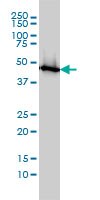DR1061 Sigma-AldrichAnti-ENO1 Mouse mAb (8G8)
Anti-ENO1, mouse monoclonal, clone 8G8, recognizes the ~45-48 kDa ENO1 in MCF-7 and HeLa cells and in human lymphoma tissue. It is validated for use in ELISA, WB, ICC, & IHC (paraffin sections).
More>> Anti-ENO1, mouse monoclonal, clone 8G8, recognizes the ~45-48 kDa ENO1 in MCF-7 and HeLa cells and in human lymphoma tissue. It is validated for use in ELISA, WB, ICC, & IHC (paraffin sections). Less<<Sinónimos: Anti-α Enolase 1
Productos recomendados
Descripción
| Replacement Information |
|---|
Tabla espec. clave
| Species Reactivity | Host | Antibody Type |
|---|---|---|
| H | M | Monoclonal Antibody |
Precios y disponibilidad
| Número de referencia | Disponiblidad | Embalaje | Cant./Env. | Precio | Cantidad | |
|---|---|---|---|---|---|---|
| DR1061-100UG |
|
100 μg |
|
— |
| References | |
|---|---|
| References | Ho, J.A., et al. 2010. Anal. Chem. 82 5944. Zhao, J., et al. 2007. Mol. Cell Proteomics. 6 987. |
| Product Information | |
|---|---|
| Form | Liquid |
| Formulation | In PBS, pH 7.30. |
| Positive control | MCF-7 cells, Human lymphoma tissue, HeLa cells |
| Preservative | None |
| Quality Level | MQ100 |
| Physicochemical Information |
|---|
| Dimensions |
|---|
| Materials Information |
|---|
| Toxicological Information |
|---|
| Safety Information according to GHS |
|---|
| Safety Information |
|---|
| Product Usage Statements |
|---|
| Packaging Information |
|---|
| Transport Information |
|---|
| Supplemental Information |
|---|
| Specifications |
|---|
| Global Trade Item Number | |
|---|---|
| Número de referencia | GTIN |
| DR1061-100UG | 04055977226027 |
Documentation
Anti-ENO1 Mouse mAb (8G8) Ficha datos de seguridad (MSDS)
| Título |
|---|
Referencias bibliográficas
| Visión general referencias |
|---|
| Ho, J.A., et al. 2010. Anal. Chem. 82 5944. Zhao, J., et al. 2007. Mol. Cell Proteomics. 6 987. |










